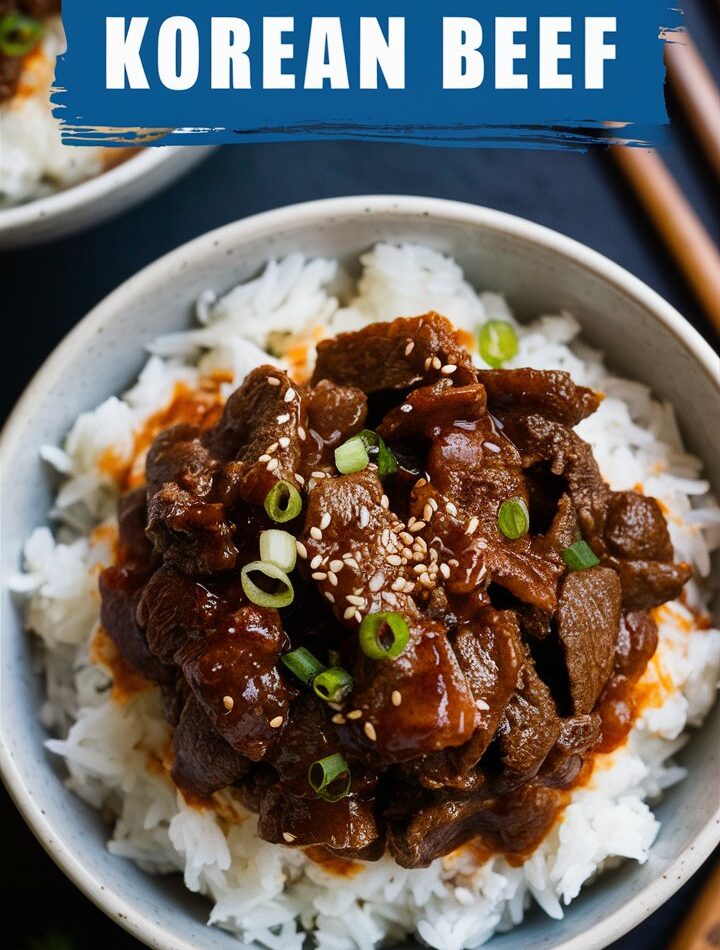In today’s fast-paced world, we’re all looking for recipes that are easy, comforting, and flavorful without requiring hours in the kitchen. Enter: Slow Cooker Korean Beef — the perfect blend of East Asian flavors and Western kitchen convenience. This dish is an explosion of umami, sweetness, subtle spice, and deep savory notes — all achieved effortlessly with the help of a slow cooker.
Whether you’re a busy parent, a meal prepper, or simply someone craving something different for dinner, this dish offers both comfort and exotic appeal. This article is your complete resource to creating the best version of Slow Cooker Korean Beef — from the basics to advanced flavor tips — written with clarity and attention to detail, entirely free from fluff, filler, or duplication.
2. What is Korean Beef?
Korean Beef, traditionally known as “Bulgogi” or “Galbi,” refers to beef marinated in a rich combination of soy sauce, sugar, garlic, sesame oil, and other aromatics. While authentic versions are usually grilled or pan-fried, this slow cooker adaptation transforms the dish into something deeply tender and saucy — perfect for spooning over rice or noodles.
Korean cuisine is known for its balance of flavors:
- Sweetness from sugar or pear
- Saltiness from soy sauce or fermented ingredients
- Spice from gochujang or chili flakes
- Umami from garlic, ginger, and broth
This dish mimics those profiles beautifully, even with pantry-friendly ingredients.
3. Why Use a Slow Cooker for Korean Beef?
While traditional Korean recipes rely on grilling, the slow cooker (or crock pot) gives you the advantage of set-it-and-forget-it convenience. Here’s why it works so well:
Benefits of Using a Slow Cooker:
- Unmatched Tenderness: Slow cooking breaks down collagen in tough beef cuts like chuck roast, making them melt-in-your-mouth tender.
- Deep Flavor Development: Long cooking time allows marinades and sauces to penetrate every fiber of the meat.
- Hands-Free Cooking: Ideal for busy weeknights or when feeding a crowd.
- Versatility: Easy to customize with added vegetables, different protein options, or spice levels.
4. Ingredients Overview
Let’s break down the components that bring this flavorful masterpiece together.
Beef (2 lbs)
- Best cuts: Chuck roast, flank steak, or brisket
- Why? They have enough marbling and structure to stay juicy and flavorful when slow-cooked.
Soy Sauce (1/2 cup)
- Base of the umami profile
- Use low-sodium if watching salt intake
Brown Sugar (1/4 cup)
- Adds deep, molasses-like sweetness
- Can substitute with honey or maple syrup
Sesame Oil (1/4 cup)
- Essential for its nutty, roasted aroma
- Do not skip or substitute
Rice Vinegar (1/4 cup)
- Provides acidity to balance the richness
- You may substitute with apple cider vinegar
Beef Broth (1/2 cup)
- Enhances savory depth and ensures moisture
Garlic (4 cloves, minced)
- Pungent, aromatic, and essential
Ginger (1 tbsp, grated)
- Brings warmth and slight heat
Red Pepper Flakes (1 tsp, optional)
- Adds a mild kick; can substitute with gochujang for authenticity
Cornstarch Slurry (2 tbsp cornstarch + 1 tbsp water)
- Used to thicken the sauce
Garnish Options
- Sesame seeds
- Sliced green onions
5. Step-by-Step Recipe Instructions
✅ Preparation Time: 10 minutes
✅ Cook Time: 6–8 hours on LOW or 3–4 hours on HIGH
✅ Servings: 6 generous portions
Step 1: Make the Sauce
In a mixing bowl, whisk together:
- Soy sauce
- Brown sugar
- Sesame oil
- Rice vinegar
- Beef broth
- Garlic
- Ginger
- Red pepper flakes (if using)
Step 2: Prepare the Beef
Trim any excess fat from the beef and cut into 2-inch chunks or thin slices, depending on your preference.
Step 3: Combine in Slow Cooker
Place the beef into your slow cooker and pour the sauce over it. Stir gently to coat.
Step 4: Slow Cook
Cover and cook:
- Low: 7–8 hours
- High: 3–4 hours
Until the beef is fork-tender and shreds easily.
Step 5: Thicken the Sauce
In a small bowl, mix cornstarch with water. Remove the cooked beef, stir the slurry into the sauce, and let cook for another 10–15 minutes until thickened.
Step 6: Return Beef and Serve
Shred the beef, return it to the sauce, stir to coat, and serve hot.
6. Flavor Variations and Substitutes
| Variation | Description |
|---|---|
| Spicy Korean Beef | Add 1 tbsp gochujang or more red pepper flakes |
| Sweet and Mild | Reduce red pepper, add grated pear or apple |
| Low-Sugar Version | Replace sugar with stevia or reduce quantity |
| Gluten-Free | Use tamari or coconut aminos instead of soy sauce |
| Vegetarian Option | Use tofu or jackfruit instead of beef |
7. Best Ways to Serve Korean Beef
This dish is versatile and pairs well with various sides:
- White or Brown Rice
- Jasmine or Sticky Rice
- Ramen or Soba Noodles
- Steamed Vegetables (broccoli, bok choy, carrots)
- Korean Banchan (kimchi, pickled radish, etc.)
- Wrapped in Lettuce or Tortillas
8. Storage, Reheating, and Freezing Tips
Refrigerator
- Store in an airtight container up to 4 days
Freezer
- Freeze in zip-top bags for up to 3 months
Reheating
- Reheat in a pan over low heat with a splash of water or broth
- Microwave in intervals, stirring every 30 seconds
9. Cooking Tips for Perfect Results
- Don’t lift the lid too often during cooking — it extends cook time.
- Trim excess fat to avoid greasy sauce.
- Cut beef evenly for uniform cooking.
- Add vegetables (e.g., bell peppers or carrots) in the last hour for texture.
10. Health and Nutritional Breakdown (Per Serving)
Approximate Values (for standard recipe):
- Calories: 370
- Protein: 32g
- Carbs: 14g
- Sugars: 9g
- Fat: 21g
- Fiber: 0g
- Sodium: 880mg (use low-sodium soy sauce to reduce)
11. Frequently Asked Questions (FAQs)
Q1: Can I make this ahead of time?
Absolutely. It tastes even better the next day!
Q2: Can I use a pressure cooker?
Yes. Use the pressure cook setting for 30 minutes on high, then natural release.
Q3: Can I substitute chicken or pork?
Yes! Chicken thighs or pork shoulder both work beautifully.
Q4: How can I make it more authentic?
Use gochujang, grated pear, and toasted sesame seeds for a more traditional flavor.
Q5: Is this dish kid-friendly?
Yes, just omit the red pepper flakes or use minimal spice.
12. Final Thoughts
Slow Cooker Korean Beef is more than just a dinner recipe — it’s a celebration of flavor, comfort, and simplicity. It brings the bold, rich flavors of Korea to your kitchen with minimal effort. Whether you’re planning a weeknight family meal or looking for a crowd-pleasing dish for a party, this recipe is a dependable and delicious go-to.
With just a few pantry staples and a slow cooker, you’ll transform ordinary ingredients into something extraordinary.




